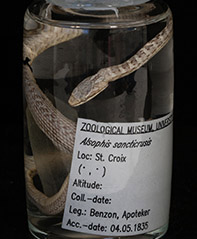Preservation
 ”Dead” natural history specimens must be preserved correctly in order to protect them against degradation. This is a complex subject, and different kinds of material compositions demand different types of storage conditions, according to how they may be affected by their surrounding environment, such as temperature, light and climate.
”Dead” natural history specimens must be preserved correctly in order to protect them against degradation. This is a complex subject, and different kinds of material compositions demand different types of storage conditions, according to how they may be affected by their surrounding environment, such as temperature, light and climate.
Collections of ”dead” natural history specimens can overall be divided into two types based on their preservation: wet and dry. Complete individuals and parts of animals and plants – so-called specimens – can be preserved both dry and wet.
Wet collections usually cover complete animals or parts of plants, which are kept permanently in alcohol (almost 70 % vol). This is the case for most of the museum’s wet collections. A small number are first fixed in formaldehyde, before being transferred to alcohol. When animals and plants are preserved in this way, it is possible to avoid soft tissue rotting and degrading away. It is also possible still to observe the outer and inner anatomy, which is important for the study of many groups.
(Photo: Jan T. B. Kristensen)
Dry collections cover a number of storage types: skeletons, skins and hides, seeds, dried plants, plants mounted on herbarium sheets, bird eggs, and most of the geological specimens, like minerals, rocks, fossils and meteorites. During dry preservation, specimens are kept at a fixed temperature and climate, as well as protected from moisture, in order to prevent them degrading.
